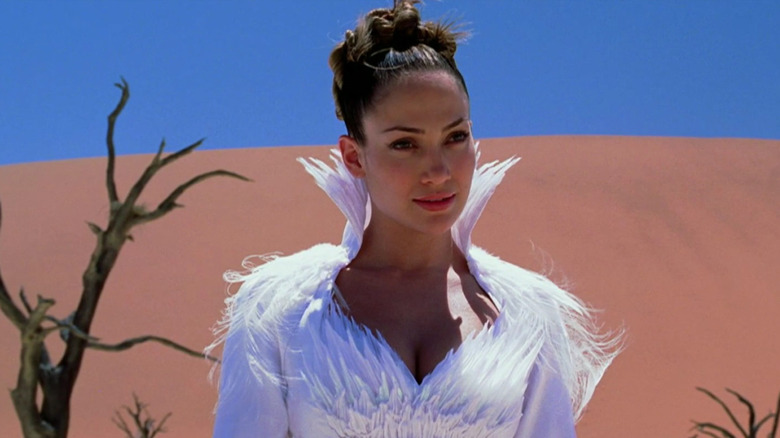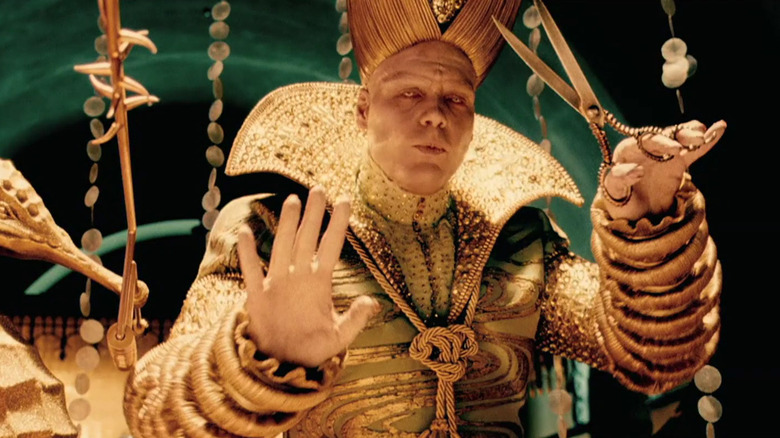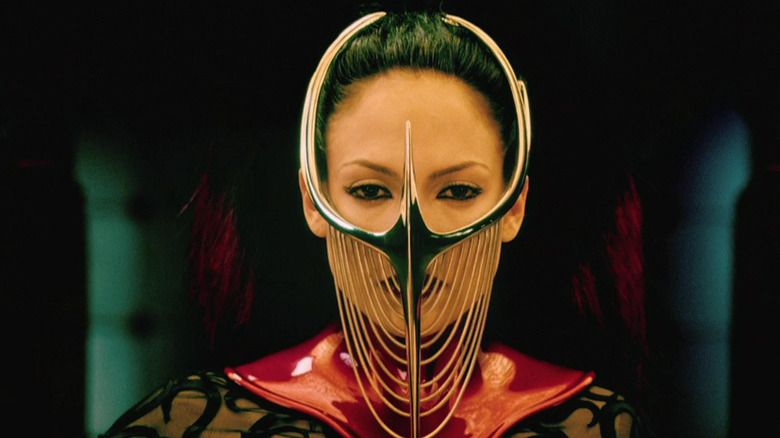A Jennifer Lopez Horror Misfire Was One Of Roger Ebert's Favorite Movies From The 2000s
Sometimes when creative people take a really big swing, large swathes of the audience just aren't going to get on board. There are a number of phenomenal movies that flopped with critics and audiences, either because they were ahead of their time or were just too weird, but at least one of those films had a serious critical contender in its corner. Tarsem Singh's misunderstood science fiction thriller "The Cell" did rather poorly with most critics but was a modest box office success, and the late, great Roger Ebert actually put it on his list of the 10 best films of the year 2000.
The films of Tarsem (he drops his surname for his professional endeavors) aren't for everyone, as he tends to prioritize visual aesthetics and big thematic overtures over more traditional storytelling, and "The Cell" can be deeply challenging for some audiences. It's a serial killer hunter story like "Silence of the Lambs" or "Kiss the Girls," but with a sci-fi twist, as child psychologist Dr. Catherine Deane (Jennifer Lopez) uses mind-connecting technology to go inside of a comatose serial killer's (Vincent D'Onofrio) mind in order to discover the location of his latest victim before an automated system drowns her. "The Cell" is a visual feast with a slightly convoluted story and some uneven acting that is nonetheless a feat of filmmaking — and besides, it's far better than some of the director's later work, like the Snow White adaptation "Mirror, Mirror" or the miserable Greek mythology-based "Immortals." "The Cell" isn't perfect, but it's deserving of Ebert's praise and will hopefully get more of a reappraisal in the future, because it's truly stunning.
The Cell is a gorgeous film with some fascinating ideas
In his entry for "The Cell" on his Best of 2000 list, where it ranked at number six, Ebert wrote, "Tarsem, the director, is a visual virtuoso who juggles his storylines effortlessly; it's dazzling, the way he blends so many notes, styles and genres into a film so original." Because large chunks of the movie take place entirely in dream worlds, surreal sets and otherworldly looking locations make "The Cell" feel alienating and unsettling in somewhat unique ways. Horror is rarely so colorful, and the production design and cinematography of "The Cell" make it one of the most beautiful-looking horror movies of all time. It also doesn't skimp on the horror, with some truly shocking moments like the demonic inner version of D'Onofrio's killer character disemboweling Special Agent Peter Novak (Vince Vaughn) on a golden rotating skewer or Catherine stumbling across a horse being vivisected by falling glass plates. Maybe that was too much for some viewers, but Ebert was sold regardless. In his 4 out of 5 star review, he said:
"I don't seek out advance information about movies because I like to go in with an open mind. Walking into the screening of 'The Cell,' I knew absolutely nothing about the plot or premise, but a TV producer in New York made a point of telling me how much she hated it, and various online correspondents helpfully told me how bad they thought it was. Did we see the same movie?"
Even in its nastiest, most gruesome moments, "The Cell" is stunning to look at and takes such giant swings that it's truly admirable. And honestly, even if it weren't for all of that, it's one of the best showcases of the work of designer Eiko Ishioka, and that's worth something.
Eiko Ishioka's costumes make The Cell unlike anything else
Japanese art director and costume designer Eiko Ishioka worked with Tarsem several times after "The Cell," including on the less-successful "Immortals" and "Mirror, Mirror." She also designed the costumes for his stunning, globe-trekking epic "The Fall," which is probably his best film and stars Lee Pace as a suicidal 1920s stunt performer who befriends a little girl with a big imagination while he's laid up in the hospital. Perhaps the Ishioka's best-known work was designing the costumes in Francis Ford Coppola's phenomenal "Bram Stoker's Dracula," when she became the first movie costumer to ever give Dracula a bit of swag.
In "The Cell," Ishioka created a number of costumes for the dream world that are truly magnificent, including one for Lopez to wear when Catherine becomes imprisoned in the killer's mind with a collar and chromed muzzle (pictured above) and the truly terrifying manifestations of the killer's inner self as he holds court as the king of his own demented castle. She also created the suits that people wear in order to use the mind-transfer technology and it's reminiscent of the incredible muscular armor Gary Oldman wore in "Dracula." Look, Vaughn's performance is really strange and the surreal nature of the dream worlds can be a little overwhelming, but "The Cell" is worth seeing for Ishioka's costumes alone, more so than any other Tarsem film. Ebert and I can't both be wrong, right?


